2008 年中国建设银行柜员招聘考试真题及答案
一、单项选择题(每小题 1 分,30 题,共 30 分)
1.传统商业银行的基本职能是(
)。
A.信用中介和流通中介
B.信用中介和支付中介
C.流动中介和支付中介
D.支付中介和信用创造
2.对国有经济理解不正确的是(
)。
A.国有经济的主导作用有利于克服市场的缺陷
B.有利于实现国民经济稳定协调发展和长期动态的平衡
C.国有企业只能存在于非竞争性领域
D.国有经济的主导作用体现在控制力上
3.马克思分析的货币流通规律(
)。
A.只适用于资本主义社会
B.适用于一切人类社会
C.只适用以私有制为基础的商品经济社会
D.适用于一切商品经济社会
4.马克思研究社会资本再生产的核心问题是(
)。
A.社会总产品的生产问题
B.社会总产品的实现问题
C.社会总产品的实物构成问题
D.社会总产品的价值构成问题
5.下列各项中,不得使用即期汇率的近似汇率进行折算的是(
)。
A.接受投资收到的外币
B.购入原材料应支付的外币
C.取得借款收到的外币
D.销售商品应收取的外币
6.垄断价格的出现表明,垄断能(
)。
A.创造出新的价值,从而不违背价值规律
B.增加商品价值总量,不受价值规律制约
C.提高或压低个别商品的价格,但受价值规律制约
D.增加商品价值总量使之与商品价格总额相等
7.若某投资项目的建设期为零,则直接利用年金现值系数计算该项目内部收益率指标所要求
�
的前提条件是(
)。
A.投产后净现金流量为普通年金形式
B.投产后净现金流量为递延年金形式
C.投产后各年的净现金流量不相等
D.在建设起点没有发生任何投资
8.在下列各项指标中,能够从动态角度反映企业偿债能力的是(
)。
A.现金流动负债比率
B.资产负债率
C.流动比率
D.速动比率
9.下列说法不正确的是(
)。
A.资本市场所交易的金融工具有较强的货币性
B.金融市场按照金融工具的属性分为基础性金融市场和金融衍生品市场
C.按证券交易的方式和次数金融市场分为初级市场和次级市场,即发行市场和流通市场,或
称一级市场和二级市场
D.金融工具一般包括债权债务凭证和所有权凭证
10.在不考虑筹款限制的前提下,下列筹资方式中个别资金成本最高的通常是(
)。
A.发行普通股
B.留存收益筹资
C.长期借款筹资
D.发行公司债券
11.资本主义信用的本质是(
)。
A.高利贷
B.银行信用
C.货币借贷
D.借贷资本
12.属于货币政策中介指标的是(
)。
A.汇率
B.超额准备金
C.利率
D.基础货币
13.在基金的存续时间内,允许证券持有人申购或购回的基金属于(
)。
A.公司型投资基金
B.契约型投资基金
�
C.封闭型投资基金
D.开放型投资基金
14.信用标准常见的表示指标是(
)。
A.信用条件
B.预期的坏账损失率
C.现金折扣
D.信用期
15.某公司股票β系数为 0.5,无风险利率为 10%,市场上所有股票的平均收益率为 12%,该
公司股票的风险收益率为(
)。
A.2%
B.12%
C.11%
D.1%
16.即付年金现值系数与普遍年金现值系数相比(
)。
A.期数减 1,系数加 1
B.期数减 1,系数减 1
C.期数加 1,系数加 1
D.期数加 1,系数减 1
17.欧洲货币市场的中心是(
)。
A.纽约
B.伦敦
C.法兰克福
D.巴黎
18.现金交易方程式可表示为(
)。
A.MV=PT
B.P=KR/M
C.Md=kPY
D.M1+M2=L1(y)+L2(r)
19.金本位制下外汇汇率上下波动的幅度受制于(
)。
A.黄金储备状况
B.外汇储备状况
C.黄金输送点
D.外汇政策
20.企业对境外经营的子公司外币资产负债表折算时,在不考虑其他因素的情况下,下列各
�
项中,应采用交易发生时即期汇率折算的是(
)。
A.存货
B.固定资产
C.实收资本
D.未分配利润
21.信用社最大一家客户贷款余额不得超过本社资本总额的%,对最大十家客户贷款余额不得
超过本社资本总额的倍。(
)
A.30;1.5
B.35;1.5
C.30;1.6
D.35;1.6
22.代理他人在金融机构开立个人存款账户,代理人应当出示(
)。
A.代理人身份证件
B.被代理人份证件
C.被代理人和代理人的身份证件
D.被代理人书面证明
23.小额支付系统未入账贷记来账或借记支付业务回执、密押错等未分发业务必须于(
)
处理完毕。
A.当日 B.次日
C.3 天内 D.5 日内
24.商业汇票的付款期限,最长不得超过(
)。
A.9 个月 B.6 个月
C.3 个月 D.1 个月
25.下列不属于农村金融机构的是(
)。
A.农村商业银行 B.邮政储蓄银行
C.村镇银行 D.农村资金互助社
26.下列金融工具中,属于长期金融工具的有个,属于间接融资工具的有个。(
)
①长期国债;②企业债券;③商业票据;④公司股票;⑤银行短期借款;⑥银行承兑汇票;
⑦大额可转让存单
A.3;3B.3;4
C.2;5D.2;4
27.某商业银行 2008 年营业收入 8000 万元,营业成本 2000 万元,营业费用 3000 万元,投
资收益 200 万元,其营业利润为(
)万元。
A.1800B.2100
�
C.3200D.4200
28.贷款人解除贷款合同的事实基础是(
)。
A.借款人有丧失偿债能力的可能
B.借款人转移财产
C.借款人在合理期限内未恢复偿债能力并且未提供担保
D.贷款人经营状况恶化
29.下列说法不正确的是(
)。
A.《商业银行法》存款自愿、取款自由、为客户保密的基本原则奠定了对客户隐私进行保护
的法律基础
B.《商业银行法》在相应章节中规定的查询客户账户信息和交易信息的法定机关种类、权限
及程序可被视为我国对客户隐私进行保护的基本规范
C.《反洗钱法》明确规定了金融机构应该对反洗钱信息保密
D.我国对客户隐私保护进行了专门的立法
30.从业务运作的实质来看,福费廷是(
)。
A.银行保函 B.保付代理
C.远期票据贴现 D.质押贷款
二、简答题(每小题 4 分,5 题,共 20 分)
1.简述金属货币制度的类型。
2.简述资本技术构成和资本价值构成的区别和联系。
3.简述储蓄机构营业终了结账工作的程序。
�
4.简述现行结汇制和售汇制的基本要求。
5.简述代理类中间业务及范围。
三,英语阅读理解
Why the inductive and mathematical sciences, after their first rapid development
at the culmination of Greek civilization, advanced so slowly for two thousand
years—and why in the following two hundred years a knowledge of natural and
mathematical science has accumulated, which so vastly exceeds all that was
previously known that these sciences may be justly regarded as the products of our
own times—are questions which have interested the modern philosopher not less than
the objects with which these sciences are more immediately conversant. Was it the
employment of a new method of research, or in the exercise of greater virtue in the
use of the old methods, that this singular modern phenomenon had its origin? Was
the long period one of arrested development, and is the modern era one of normal
growth? Or should we ascribe the characteristics of both periods to so-called
historical accidents—to the influence of conjunctions in circumstances of which
no explanation is possible, save in the omnipotence and wisdom of a guiding
Providence?
The explanation which has become commonplace, that the ancients employed
deduction chiefly in their scientific inquiries, while the moderns employ induction,
proves to be too narrow, and fails upon close examination to point with sufficient
distinctness the contrast that is evident between ancient and modern scientific
doctrines and inquiries. For all knowledge is founded on observation, and proceeds
from this by analysis, by synthesis and analysis, by induction and deduction, and
if possible by verification, or by new appeals to observation under the guidance
of deduction—by steps which are indeed correlative parts of one method; and the
ancient sciences afford examples of every one of these methods, or parts of one method,
�
which have been generalized from the examples of science.
A failure to employ or to employ adequately any one of these partial methods,
an imperfection in the arts and resources of observation and experiment,
carelessness in observation, neglect of relevant facts, by appeal to experiment and
observation—these are the faults which cause all failures to ascertain truth,
whether among the ancients or the moderns; but this statement does not explain why
the modern is possessed of a greater virtue, and by what means he attained his
superiority. Much less does it explain the sudden growth of science in recent times.
The attempt to discover the explanation of this phenomenon in the antithesis
of “facts” and “theories” or “facts” and “ideas”—in the neglect among the
ancients of the former, and their too exclusive attention to the latter—proves also
to be too narrow, as well as open to the charge of vagueness. For in the first place,
the antithesis is not complete. Facts and theories are not coordinate species.
Theories, if true, are facts—a particular class of facts indeed, generally complex,
and if a logical connection subsists between their constituents, have all the
positive attributes of theories.
Nevertheless, this distinction, however inadequate it may be to explain the
source of true method in science, is well founded, and connotes an important
character in true method. A fact is a proposition of simple. A theory, on the other
hand, if true has all the characteristics of a fact, except that its verification
is possible only by indirect, remote, and difficult means. To convert theories into
facts is to add simple verification, and the theory thus acquires the full
characteristics of a fact.
1. The title that best expresses the ideas of this passage is
[A]. Philosophy of mathematics. [B]. The Recent Growth in Science.
[C]. The Verification of Facts. [C]. Methods of Scientific Inquiry.
2. According to the author, one possible reason for the growth of science during
the days of the ancient Greeks and in modern times is
[A]. the similarity between the two periods.
[B]. that it was an act of God.
[C]. that both tried to develop the inductive method.
[D]. due to the decline of the deductive method.
3. The difference between “fact” and “theory”
[A]. is that the latter needs confirmation.
�
[B]. rests on the simplicity of the former.
[C]. is the difference between the modern scientists and the ancient Greeks.
[D]. helps us to understand the deductive method.
4. According to the author, mathematics is
[A]. an inductive science. [B]. in need of simple verification.
[C]. a deductive science. [D]. based on fact and theory.
5. The statement “Theories are facts” may be called.
[A]. a metaphor. [B]. a paradox.
[C]. an appraisal of the inductive and deductive methods.
[D]. a pun.
�
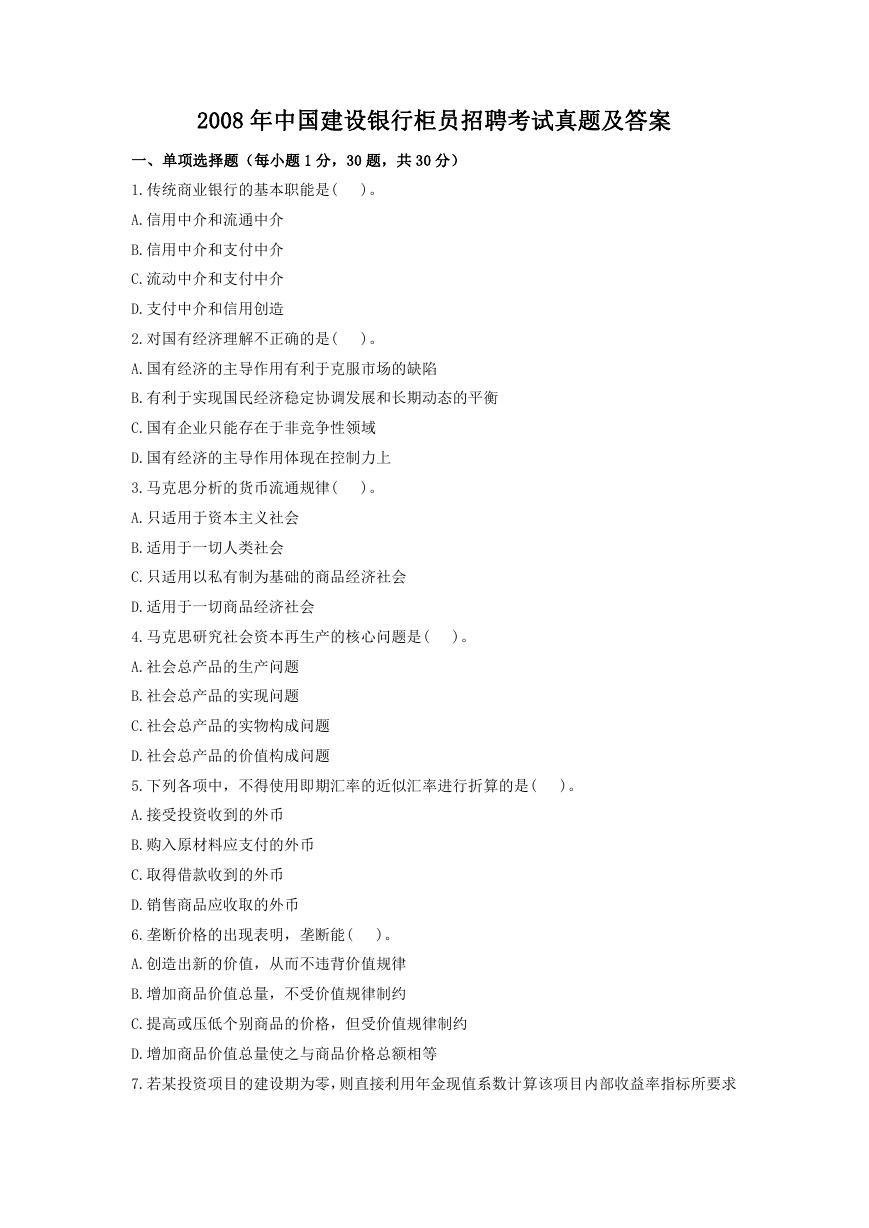
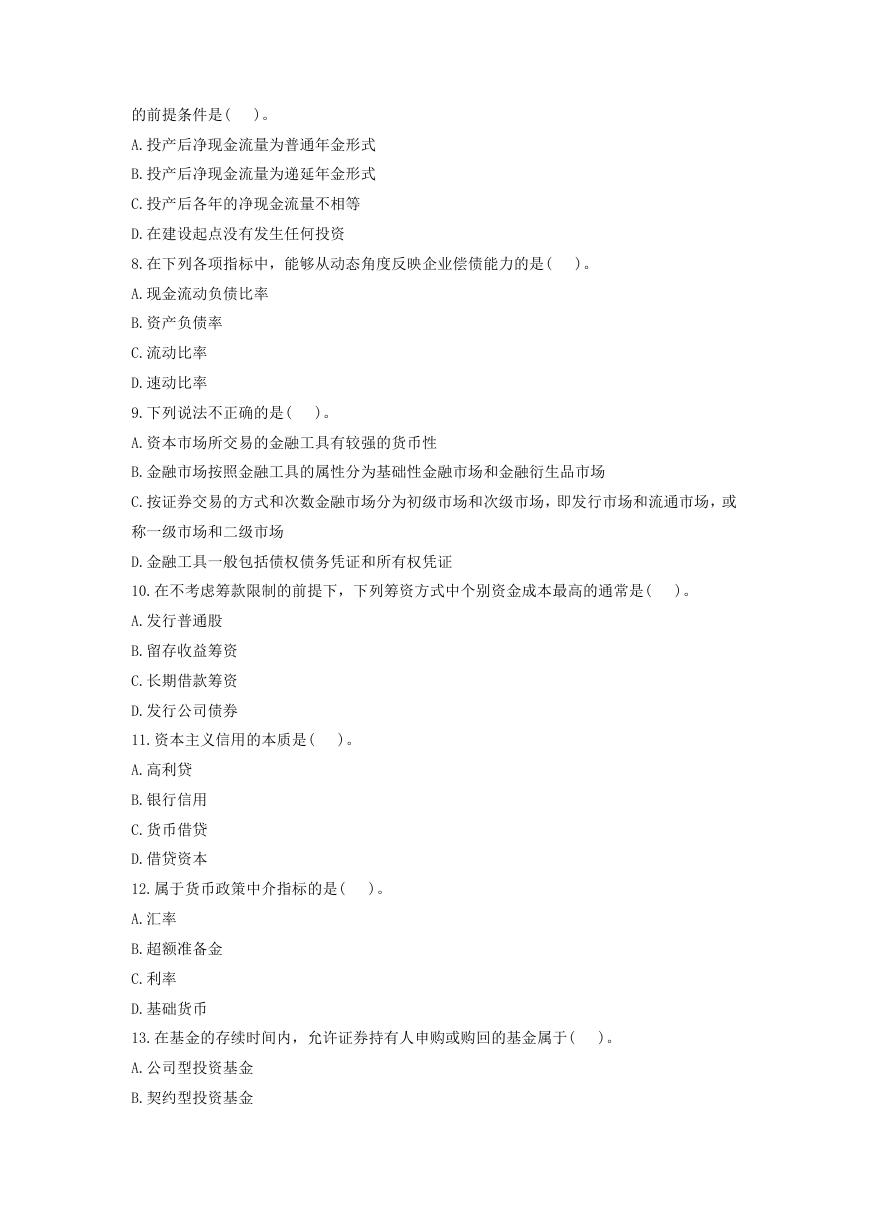
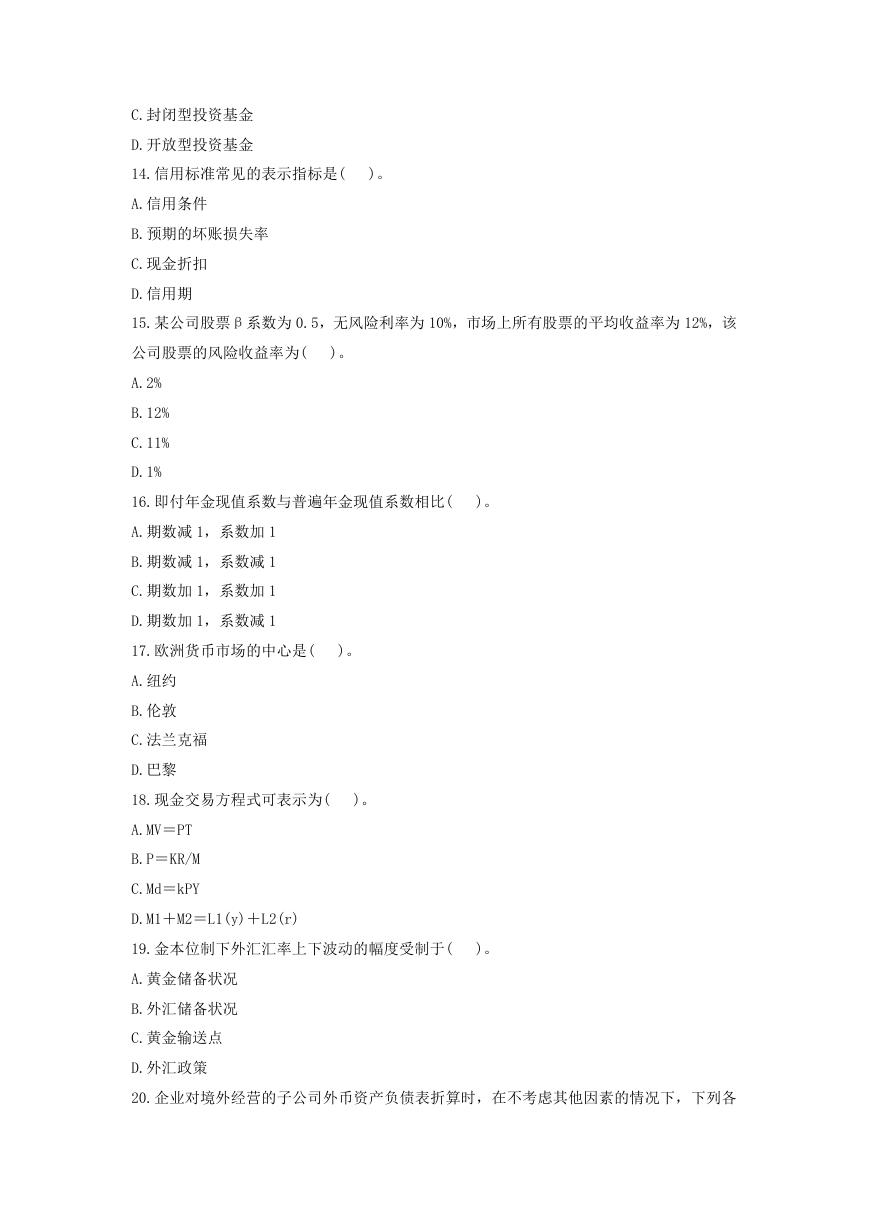

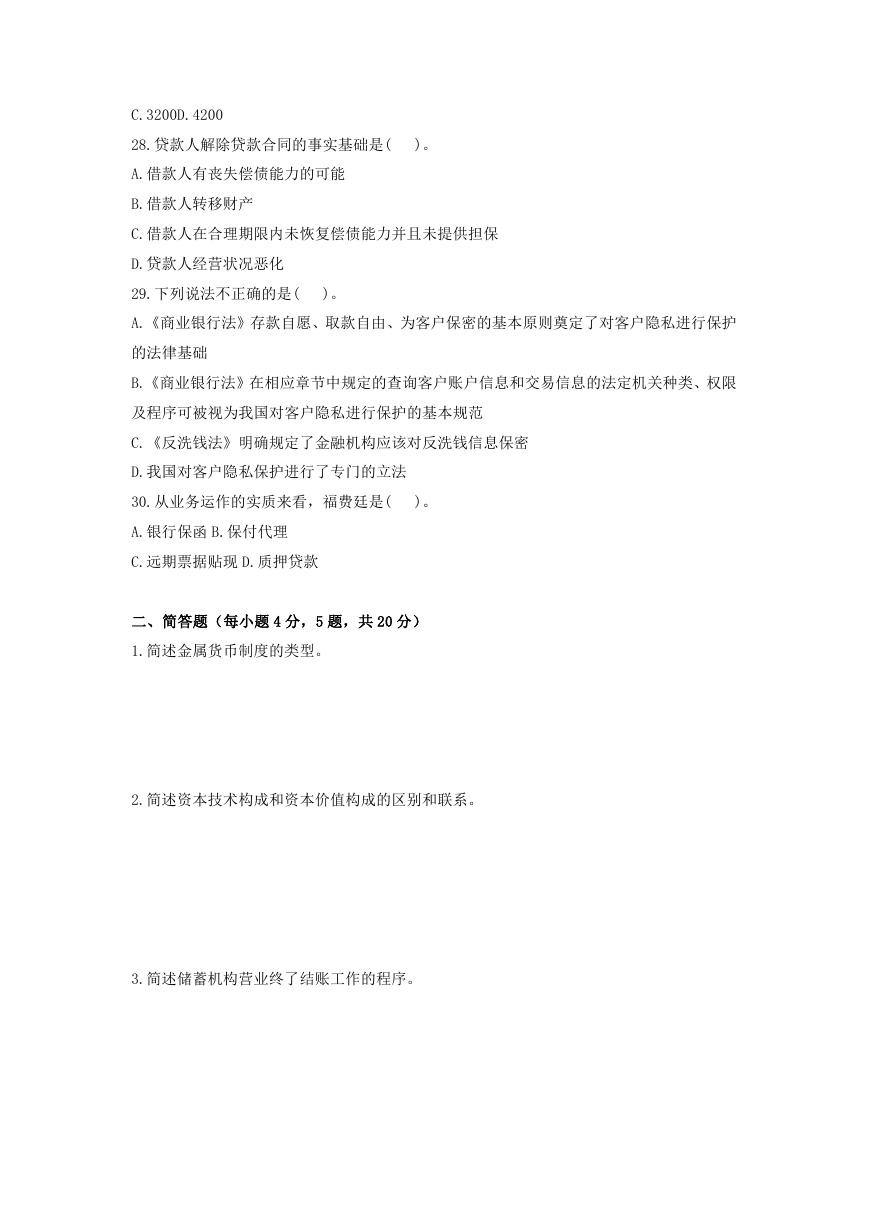

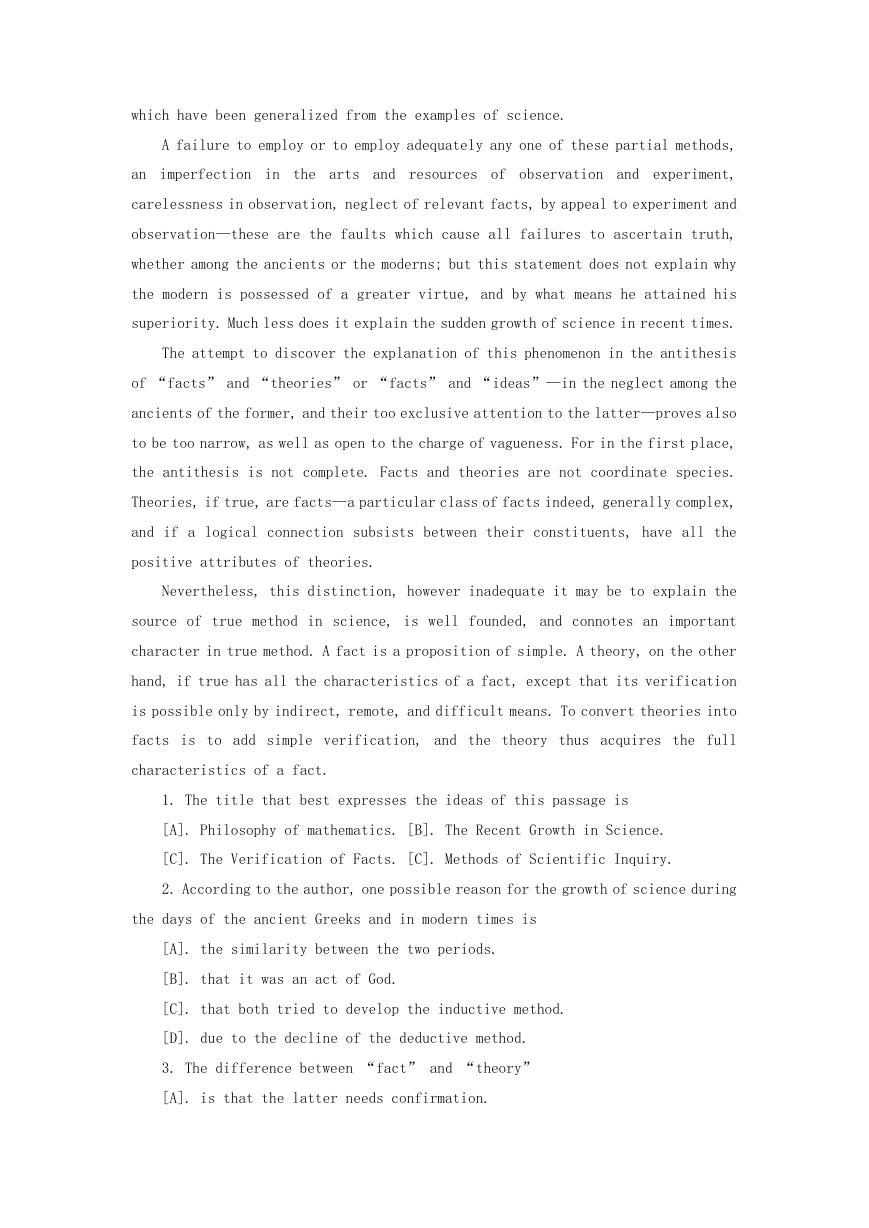
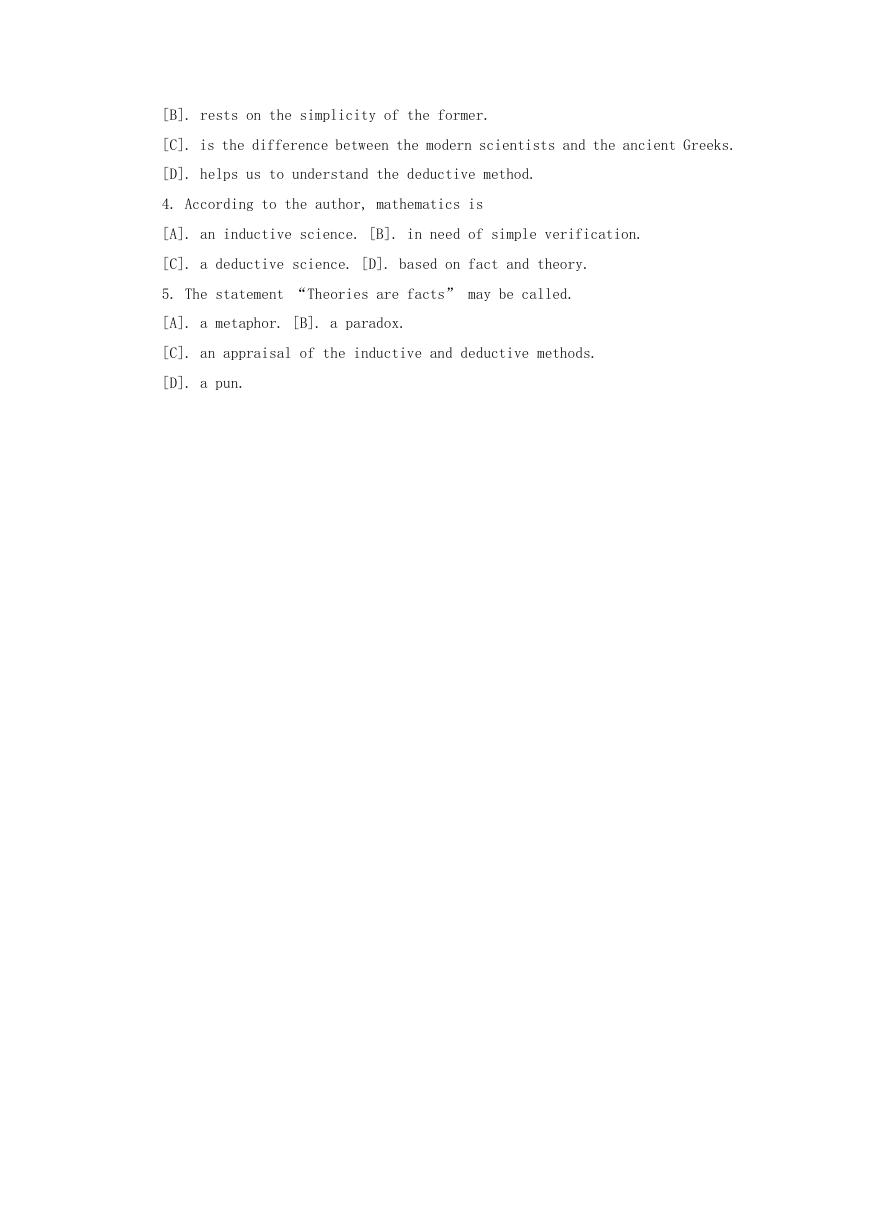








 2023年江西萍乡中考道德与法治真题及答案.doc
2023年江西萍乡中考道德与法治真题及答案.doc 2012年重庆南川中考生物真题及答案.doc
2012年重庆南川中考生物真题及答案.doc 2013年江西师范大学地理学综合及文艺理论基础考研真题.doc
2013年江西师范大学地理学综合及文艺理论基础考研真题.doc 2020年四川甘孜小升初语文真题及答案I卷.doc
2020年四川甘孜小升初语文真题及答案I卷.doc 2020年注册岩土工程师专业基础考试真题及答案.doc
2020年注册岩土工程师专业基础考试真题及答案.doc 2023-2024学年福建省厦门市九年级上学期数学月考试题及答案.doc
2023-2024学年福建省厦门市九年级上学期数学月考试题及答案.doc 2021-2022学年辽宁省沈阳市大东区九年级上学期语文期末试题及答案.doc
2021-2022学年辽宁省沈阳市大东区九年级上学期语文期末试题及答案.doc 2022-2023学年北京东城区初三第一学期物理期末试卷及答案.doc
2022-2023学年北京东城区初三第一学期物理期末试卷及答案.doc 2018上半年江西教师资格初中地理学科知识与教学能力真题及答案.doc
2018上半年江西教师资格初中地理学科知识与教学能力真题及答案.doc 2012年河北国家公务员申论考试真题及答案-省级.doc
2012年河北国家公务员申论考试真题及答案-省级.doc 2020-2021学年江苏省扬州市江都区邵樊片九年级上学期数学第一次质量检测试题及答案.doc
2020-2021学年江苏省扬州市江都区邵樊片九年级上学期数学第一次质量检测试题及答案.doc 2022下半年黑龙江教师资格证中学综合素质真题及答案.doc
2022下半年黑龙江教师资格证中学综合素质真题及答案.doc